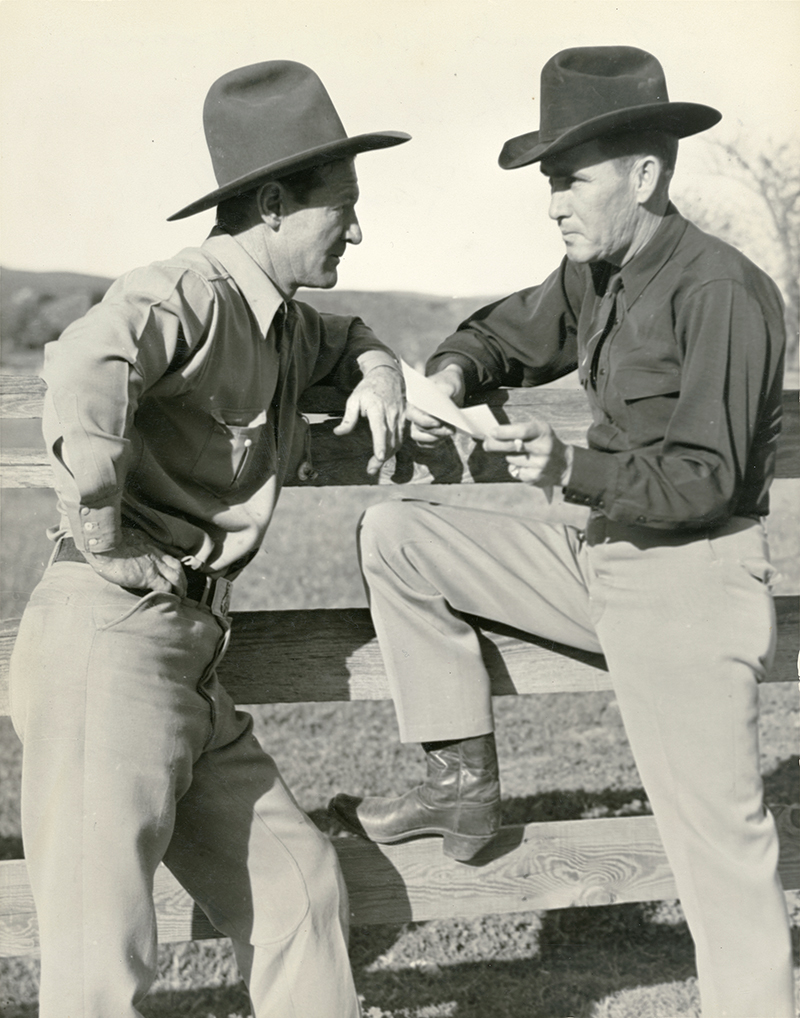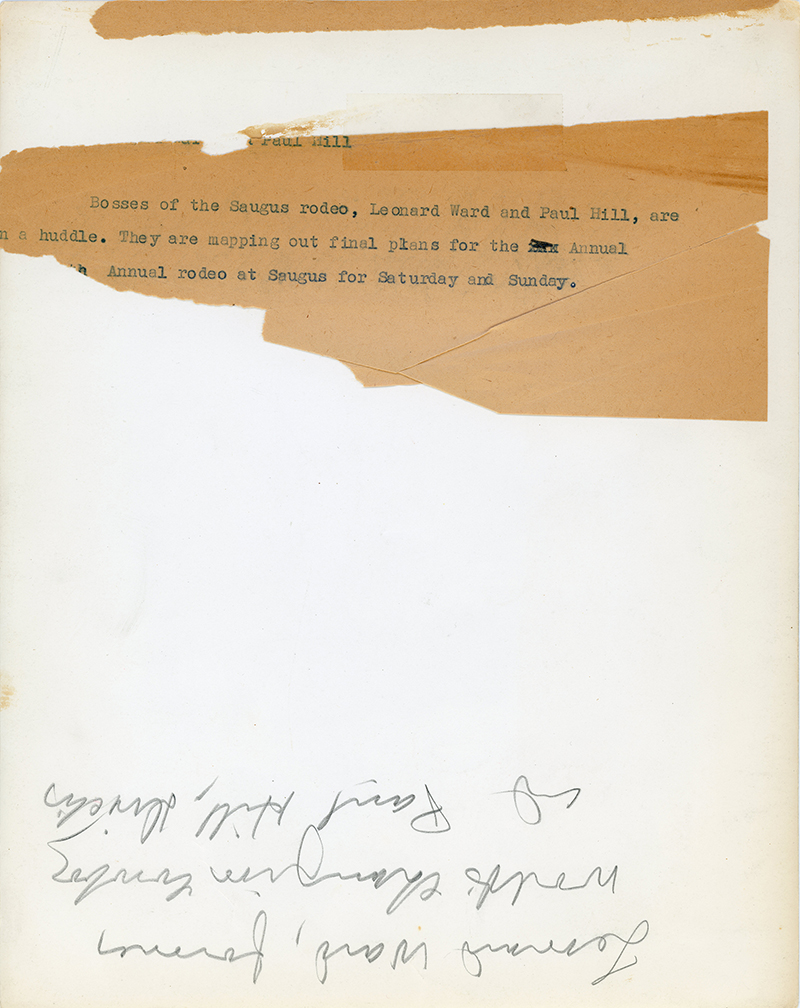|
|


Click image to enlarge
Rodeo champion Leonard Ward (left) and Saugus Rodeo owner Paul Hill. This 8x10 publicity photo is undated, but it's probably 1936 or (more likely) 1937 because: • Ward lived in the main house at the Saugus rodeo grounds from 1935 to 1937 (then known as the Hoot Gibson house, where Gibson married Sally Eilers in 1930, later known as the Bonelli House). • Hill, a stockman, bought the Saugus rodeo (later known as Saugus Speedway) from Gibson in 1934, when Gibson was financially destitute. Hill would suffer a similar fate after the Great Flood of March 2, 1938, but the rodeo was still OK in 1937. • A handwritten inscription on the back of the photograph identifies Ward as "former" world champion. He was world champion in 1934. • Hill and Ward registered together for the January 1937 Rodeo Association of America convention in Reno. (See Reno Evening Gazette, January 29, 1937). • Ward was the assistant arena director of the 1937 Saugus Rodeo. Cutline reads:
Bosses of the Saugus rodeo, Leonard Ward and Paul Hill, are in a huddle. They
are mapping out final plans for the Annual [Hill's Ranch] rodeo at Saugus for Saturday and Sunday.
Leonard Ward biography from Pro Rodeo Hall of Fame (inducted 2009):
One of the best all-around hands from the first half of the 20th century, Leonard Ward had his greatest year in 1934 when he won the saddle bronc riding, bareback riding and all-around world championships, becoming the first cowboy to achieve a Triple Crown by winning three gold buckles in the same year. Ward won 16 rodeos that year, in bronc riding, steer decorating, bull riding and bareback riding. He continued to compete at a high level until he suffered a badly broken leg at the 1937 California Rodeo Salinas that put him in the hospital for six months and in rehab for another six. Ward left the sport for good at age 38 in 1941 to take a construction job in the North Pacific Ocean, first on Midway Island and then on Wake Island, where he was captured by the Japanese on Dec. 23, 1941 and held prisoner for 45 months, doing forced labor on Wake Island and in Japan. After his release, Ward returned to construction work and ranching in Oregon — he operated a dude ranch in Talent, Ore., where John F. Kennedy stayed during the 1960 presidential campaign — until his death in 1985. World Championships: 3 (all-around, bareback riding, saddle bronc, 1934)
Born August 21, 1903 in Chehalis, Washington
About Saugus Speedway. The future Saugus Speedway was built originally as a rodeo arena in 1927 by Roy Baker, brother of shoe magnate C.H. Baker. Roy Baker purchased the 40-acre property east of Bouquet Junction in 1923 for the purpose of breeding and selling show and pleasure horses. To that end he imported saddle brood mares from Kentucky and studded them with a pedigreed, chestnut-colored saddlebred stallion named Peavine McDonald (b. 1910), which sired five pedigreed mares and four pedigreed colts between 1920 and 1936. Baker advertised that he had 2,500 acres of grazing land and also offered training and boarding services for outside horses. Probably to attract horse buyers to his ranch in faraway Saugus, Baker staged rodeos. Some references suggest he built a 12,000-seat arena in 1924, but this is dubious. (Promoter Bob Anderson organized a local rodeo in 1924, but its exact location is unclear, and it wouldn't have had grandtands.) Anderson did hold the annual rodeo on Baker's property in April 1926. That December, Baker and Anderson started construction on a new stadium, complete with partially covered grandstand seating and a quarter-mile oval track. When it opened May 1, 1927, it seated 18,000 fans, and thousands more had to be turned away for lack of room. Over the next decade, ownership of the arena would change hands three more times. As with a majority of the American populace, Baker was hit hard financially by the Great Depression of 1929 and was forced to sell the stadium to cowboy actor Hoot Gibson in 1930. Gibson continued to hold rodeos at the stadium and drew a Hollywood crowd including famous actors such as William S. Hart, Harry Carey, Tom Mix, and John Wayne. He also used the stadium as a movie set or leased it to other companies for film making. But Gibson felt the effects of the Depression, as well. In September 1933 he appeared in a Los Angeles courtroom and pleaded poverty, saying he had no assets with which to repay a $2,500 loan. He testified that he owned a one-third interest in Hoot Gibson Inc., which owned the Saugus rodeo, and that it was in arrears. In 1934, Gibson sold the stadium to Paul Hill, owner of the Western Livestock Stockyards, who continued to call it the Hoot Gibson Rodeo. As with his predecessors, however, the stadium brought Hill financial hardship when it was hit by the Great Flood of March 2, 1938. Heavy rains that year caused a river of water to flow down Soledad Canyon and filled the ranch home and arena with mud and debris. As reported in the Los Angeles Times, the "old buildings ... collapsed during the March floods" and the arena was built anew. Nonetheless, Hill lost the ranch sometime after the April 1938 rodeo. According to Reynolds, the property was repossessed by the bank. In 1939, ownership passed to William Bonelli, and it was renamed Bonelli Stadium. Bonelli, a professor of economics at Occidental College, continued the annual rodeo tradition for a number of years but introduced auto racing in 1939 on a more frequent schedule; ultimately auto racing became the primary draw and Bonelli renamed the arena Saugus Speedway. Occasional rodeos and circuses continued until at least the late 1960s, auto racing until 1995. The facility was sometimes used for concerts before the grandstands were removed in 2012 (the originals had been replaced in 1955). The venue continues to host an outdoor swap meet.
LW3213: 9600 dpi jpeg from original photograph purchased 2018 by Leon Worden.
|
The site owner makes no assertions as to ownership of any original copyrights to digitized images. However, these images are intended for Personal or Research use only. Any other kind of use, including but not limited to commercial or scholarly publication in any medium or format, public exhibition, or use online or in a web site, may be subject to additional restrictions including but not limited to the copyrights held by parties other than the site owner. USERS ARE SOLELY RESPONSIBLE for determining the existence of such rights and for obtaining any permissions and/or paying associated fees necessary for the proposed use.



